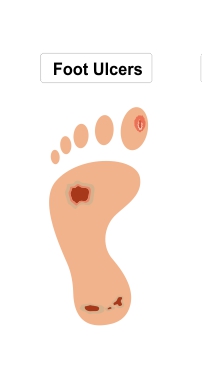Foot Care for Diabetic Foot Ulcers
Diabetic foot ulcer is a condition that can slip into infections and foot amputations. It needs constant and continuous care not only to treat the condition, but to avoid further damage. In most cases, unmanaged diabetic ulcers lead to foot amputations and loss of limbs.
What is Diabetic Foot Ulcer?
Diabetic foot ulcer is a major diabetes complication that appear as open and exposed wounds that take a lot of time to heal. Along with diabetic neuropathy, peripheral artery disease, and diabetic foot infection, it is a major component of diabetic foot.
In this condition, skin does not grow back on the wound due to changes caused by diabetes. This leaves an open area with the inner tissue visible outside. Since diabetes causes poor blood flow and slow wound healing, these foot ulcers are not closed. An underlying cause for this includes diabetic dermopathy.
Occurring commonly among people with diabetes, diabetic foot ulcers are caused due to changes in the blood vessels, damage to the nerves, and changes to the skin as a result of diabetes. They also occur due to changes in the muscles and bones caused by diabetes.
Diabetic Foot Ulcer – Who are at risk?
- People with diabetic nerve damage (diabetic neuropathy)
- People with diabetic angiopathy (blood vessel damage)
- Peripheral artery disease
- Uncontrolled diabetes
- Smoking
- Obesity
- High cholesterol
- High blood pressure
- People with other diabetes complications like kidney damage, and eye damage
- People wearing ill-fitting footwear and who walk barefoot
Changes brought about by diabetes affect the entire feet along with its blood vessels, nerves, muscles, bones, and skin. Mechanical stress, minor injuries, cuts, corns and calluses to the feet trigger diabetic foot ulcer.
If diabetic foot ulcers are not treated aggressively and in the early stages, it can lead to foot amputation. Stages of diabetic foot ulcer range from superficial ulceration to deep ulceration with tendon and bone involvement.
- In stage one, diabetic foot ulcer has not developed, but there are chances if blood sugar levels are not controlled.
- In stage two, nerve damage has already begun along with blood vessel damage. At this stage, a person is at a high risk of diabetic foot ulcer.
- In stage three, diabetic foot ulcer has already begun and there is need for aggressive management
- In stage four, the ulcer has deepened as the tissue inside is clearly visible. There is abscess.
- In stage five, there is diabetic foot infection and the soft tissue in the ulcer has begun to die. This stage proceeds further to development of gangrene, which demands foot amputation.
Diabetic foot ulcers are diagnosed by physical examination, blood sugar tests, levels of creatinine, and a complete blood count.
Foot Care for Diabetic Foot Ulcer
Care for diabetic foot ulcers depend upon the stage of the ulcer. It involves controlling blood sugar levels aggressively in order to improve wound healing. Exposed wounds are constantly cleaned and topical antibiotic ointments are applied. Since there is loss of sensation in the feet due nerve and muscle damage, orthotics and diabetes shoes are provided.
In latter stages where there is both nerve and blood vessel involvement, daily wound care, debridement, and vascular intervention is advised. When diabetic foot ulcers progress to diabetic foot infection, surgical intervention might be needed. There might be loss of limb due to amputation.
How to Prevent Diabetic Foot Ulcer
- Wear protective diabetic footwear from the diagnosis of diabetes
- Wear well cushioned insoles in shoes in order to prevent undue pressure
- Attain blood sugar level targets
- Control blood pressure and cholesterol levels
- Reduce weight to reduce mechanical stress on feet
- Never walk barefoot and never neglect minor cuts or injuries to the feet
- Maintain foot hygiene with washing, cleaning, and moisturizing
- Get periodical feet examinations with a podiatrist and consult a diabetes doctor for diabetes control











